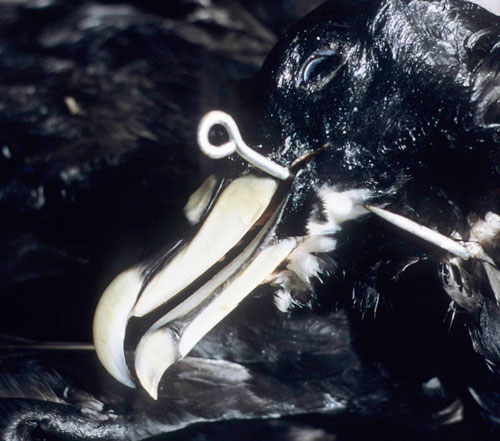Karine Delord of the Centre d'Études Biologiques de Chizé, France and colleagues have studied the spatial relationships between White-chinned Petrels Procellaria aequinoctialis breeding at Kerguelen and longline fisheries in the Southern Ocean, publishing their findings this month in the journal Endangered Species Research.
The paper's abstract follows:
"Incidental seabird mortality associated with longline commercial fishing is a worldwide conservation concern. To develop conservation strategies, it is essential to estimate the likelihood of seabird bycatch and the degree of overlap between birds' foraging grounds and commercial fishing areas. We tracked 21 adult White-chinned Petrels Procellaria aequinoctialis breeding on Kerguelen Island, southern Indian Ocean, during their breeding period in 2006 and in 2008. At-sea foraging distribution of White-chinned Petrels was mainly confined to Antarctic waters. Commercial longline fisheries targeting toothfish were operating in both the French Exclusive Economic Zone and in other Commission for the Conservation of Antarctic Marine Living Resources areas during the study. We analysed concurrent data on the positions of both birds and vessels to estimate overlap. Static analysis using indices (home-range and utilization distribution overlap) revealed that, at a large scale, spatial and temporal overlap occurred, but varied among areas and with breeding stage. Dynamic analysis (detection of operating vessels respective to bird locations within a time/space window) revealed little overlap at a small scale. Our study revealed a mismatch between large- and small-scale overlap estimates, suggesting that birds and vessels occupy the same overall zone with infrequent co-occurrence (19% of birds in the vicinity of vessels). This result was confirmed by the relatively low occurrence of fishery-related items (4 to 22%) in chick food samples. However, given the large size of seabird populations, overall, large numbers of birds overlap with vessels, and management authorities should maintain and promote the implementation of strict mitigation measures to further reduce bycatch."

Reference:
Delord, K., Cotté, C., Péron, C., Marteau, M., Pruvost, P., Gasco, N., Duhamel, G., Cherel, Y. & Weimerskirch, H. 2010. At-sea distribution and diet of an endangered top predator: relationship between White-chinned Petrels and commercial longline fisheries. Endangered Species Research 13: 1-16.
John Cooper, ACAP Information Officer, 17 December 2010

 English
English  Français
Français  Español
Español